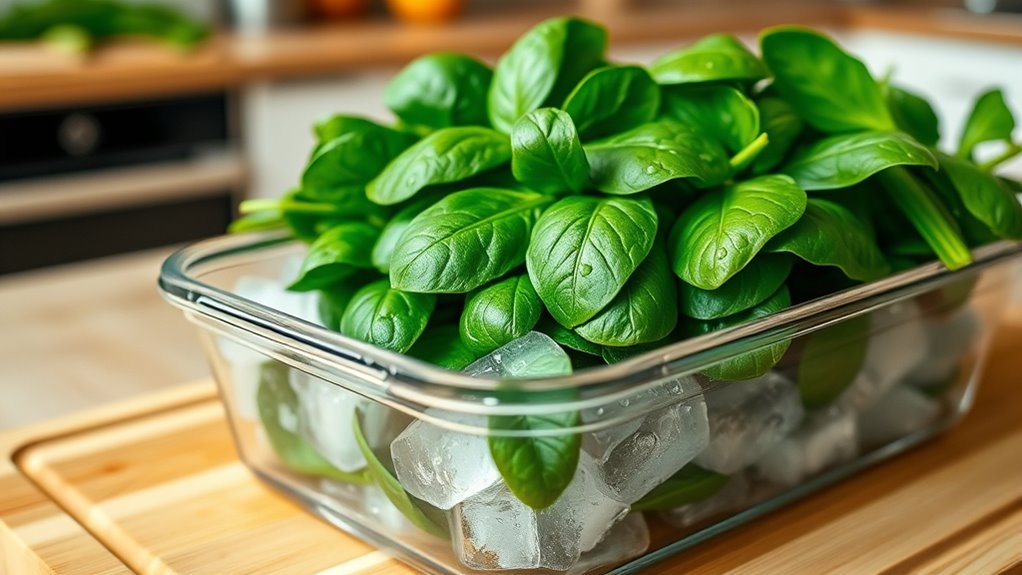To keep your spinach fresh, start with a visual inspection; discard any wilted or discolored leaves. Store it in airtight containers or perforated bags to maintain moisture levels. Place spinach in the crisper drawer of your fridge at around 32°F, using wet paper towels for humidity. Keep it away from ethylene-producing fruits. For long-term storage, consider drying or freezing spinach to extend its shelf life. There's more to learn about optimizing your storage techniques!
Key Takeaways
- Conduct a visual inspection and discard any wilted or discolored leaves before storage.
- Use airtight containers or perforated bags to maintain moisture and airflow.
- Store spinach in the crisper drawer at around 32°F with high humidity levels.
- Layer a damp paper towel with spinach in sealed bags to retain moisture.
- Regularly check for spoilage to ensure you enjoy spinach at its freshest.
Quality Check Before Storage
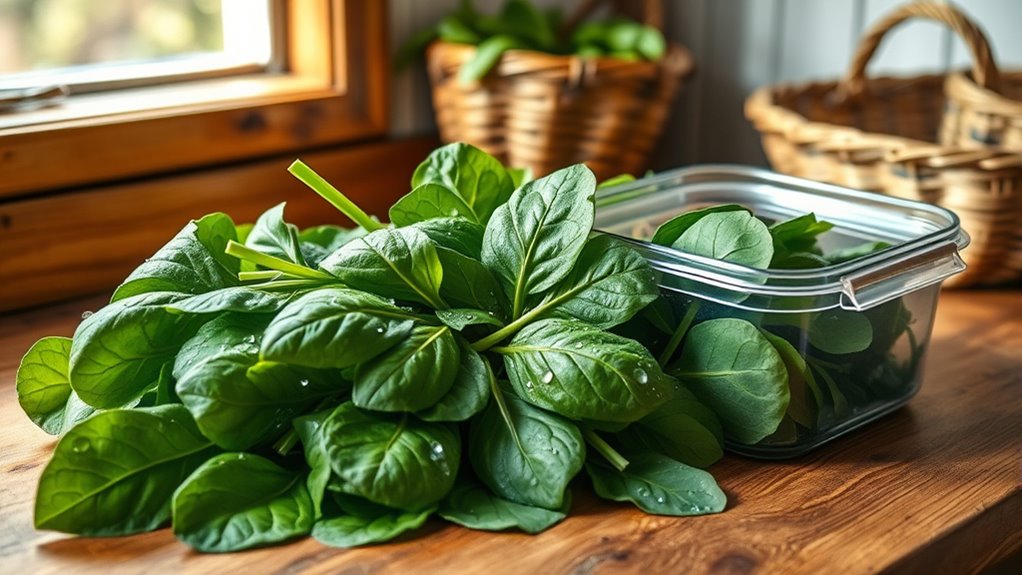
Before you store spinach, it's essential to conduct a quality check to ensure you're keeping only the freshest leaves.
Start with a visual inspection; look for any yellow or brown discoloration, which signals spoilage. Discard wilted or rotting leaves to prevent them from affecting the good ones.
Begin by visually inspecting the spinach for any yellow or brown discoloration, discarding wilted or rotting leaves to protect the fresh ones.
Check the moisture levels, as high moisture can lead to quicker spoilage. Make sure the packaging isn't damaged or compromised.
A quick smell test can also help; any off odors indicate spoilage. By sorting through the spinach and removing damaged leaves, you're setting the stage for optimal storage.
Importance of Drying Spinach
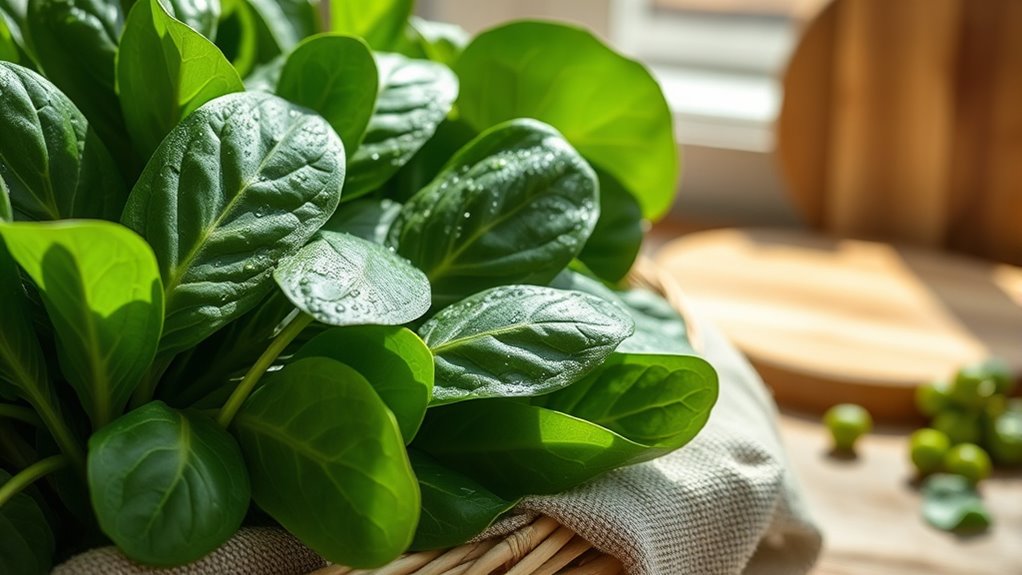
Once you've sorted and prepared your spinach, drying it becomes a valuable step in preserving its quality.
Drying spinach not only extends its shelf life but also retains essential nutrients like vitamins A and K, iron, and folate. By dehydrating, you save space in your pantry, making it easier to store.
Dried spinach is versatile, perfect for adding to soups or smoothies, and it helps reduce food waste by using excess spinach efficiently. Plus, it lasts for months when stored properly, offering convenience for meal prep.
With easy rehydration, you can enjoy its benefits anytime, making drying a cost-effective choice that maximizes the nutritional value of your spinach.
Choosing the Right Storage Containers
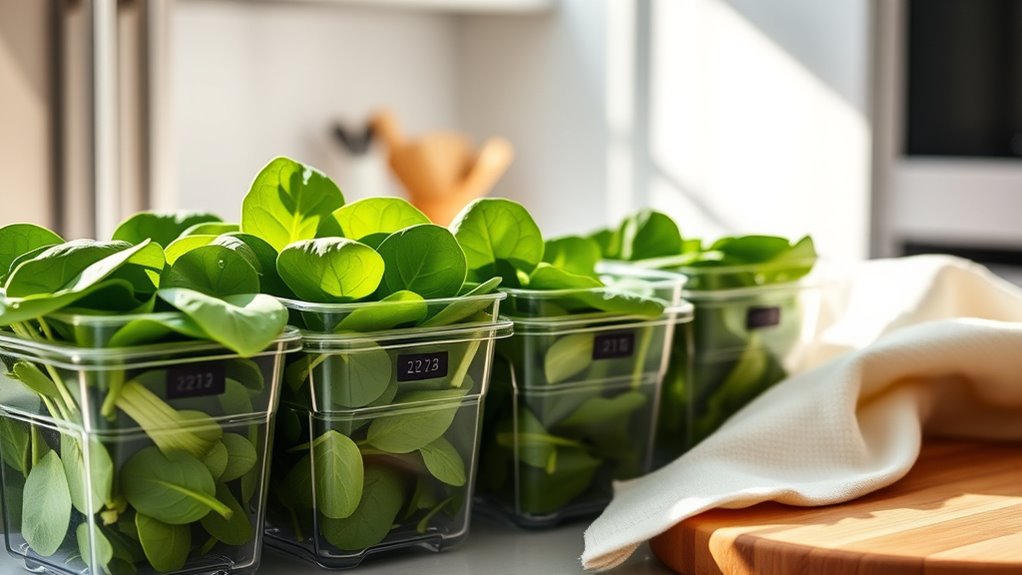
Choosing the right storage containers is crucial for keeping your spinach fresh and nutritious. Airtight containers prevent moisture from affecting your greens, while breathable options like perforated plastic bags allow airflow to reduce spoilage.
Consider eco-friendly silicone bags, which are dishwasher safe and versatile for both fridge and freezer storage. If you use plastic containers, opt for reusable ones to minimize waste.
To enhance moisture control, line your containers with paper towels or layer bread slices with spinach. This absorbs excess moisture, extending freshness.
Optimal Refrigeration Techniques
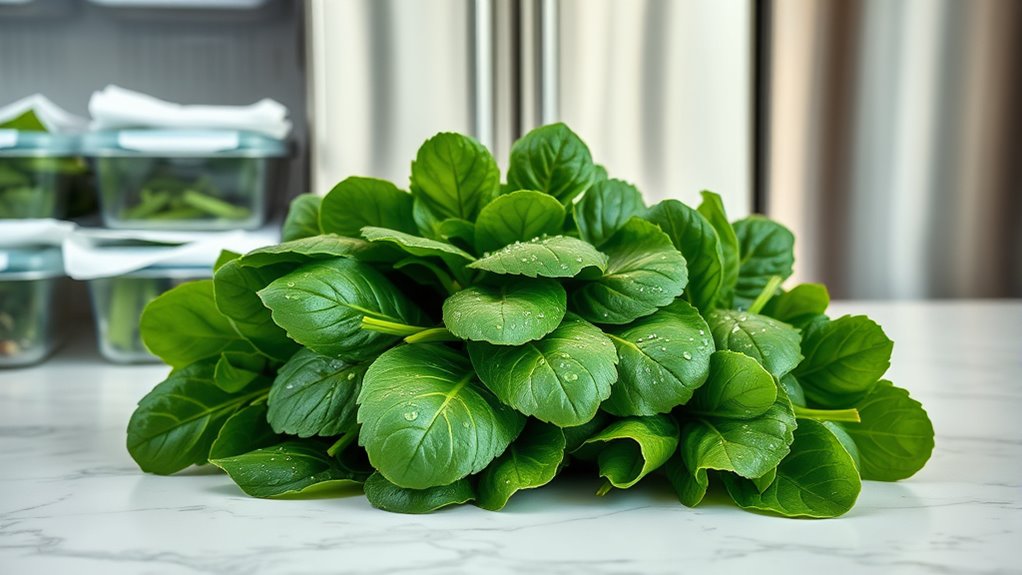
To keep your spinach at its freshest, it's essential to implement optimal refrigeration techniques. Store your spinach at around 32°F, as warmer temperatures won't preserve freshness, while colder ones might cause freeze damage.
The crisper drawer is ideal since it maintains a consistent temperature. To maintain high humidity levels (about 95% to 100%), consider using wet paper towels and breathable containers, but avoid washing spinach until you're ready to use it to prevent excess moisture.
Keep spinach away from ethylene-producing fruits like apples and bananas to slow spoilage. To enhance freshness, place a dry paper towel on top of the spinach and ensure you store it in a sealed bag with minimal air.
Regularly check for any spoiled leaves.
Understanding Spinach Shelf Life
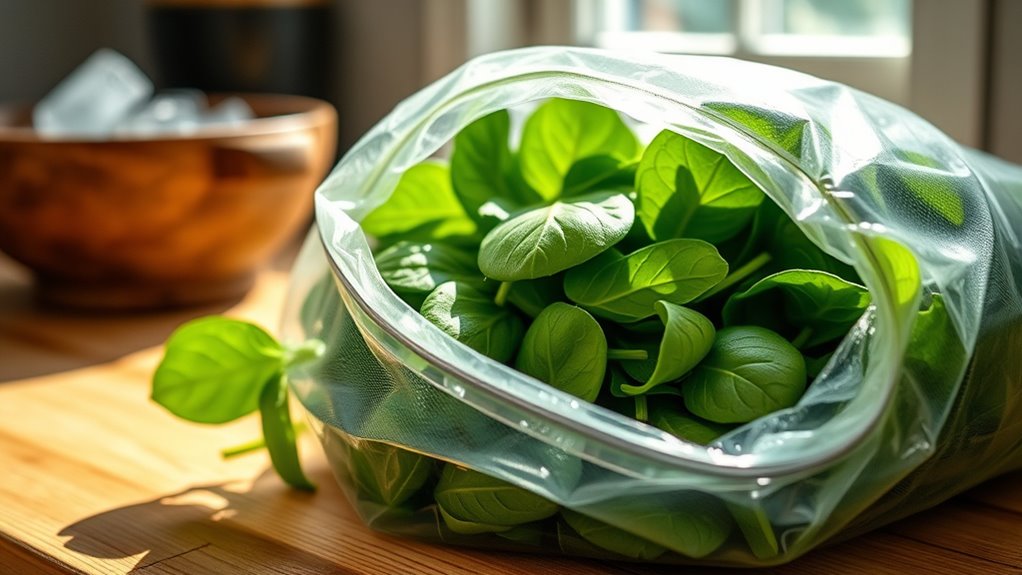
Understanding spinach shelf life is crucial for maximizing its freshness and nutritional value. Several factors influence how long your spinach lasts, including temperature, humidity, and packaging.
Whole spinach leaves typically remain fresh for 5-7 days in an unopened bag but only 3-5 days in an opened one. Chopped spinach has an even shorter shelf life of 1-2 days due to increased surface exposure.
Whole spinach leaves last 5-7 days unopened, while opened bags reduce freshness to 3-5 days; chopped spinach lasts just 1-2 days.
To maintain optimal conditions, store spinach in a moisture-resistant container in the crisper drawer of your refrigerator. Remember, ambient conditions can reduce shelf life to just 3 days.
Regularly check your spinach for spoilage to ensure you're enjoying it at its best. Proper storage can make a real difference in how long it lasts.
Tips for Maintaining Freshness
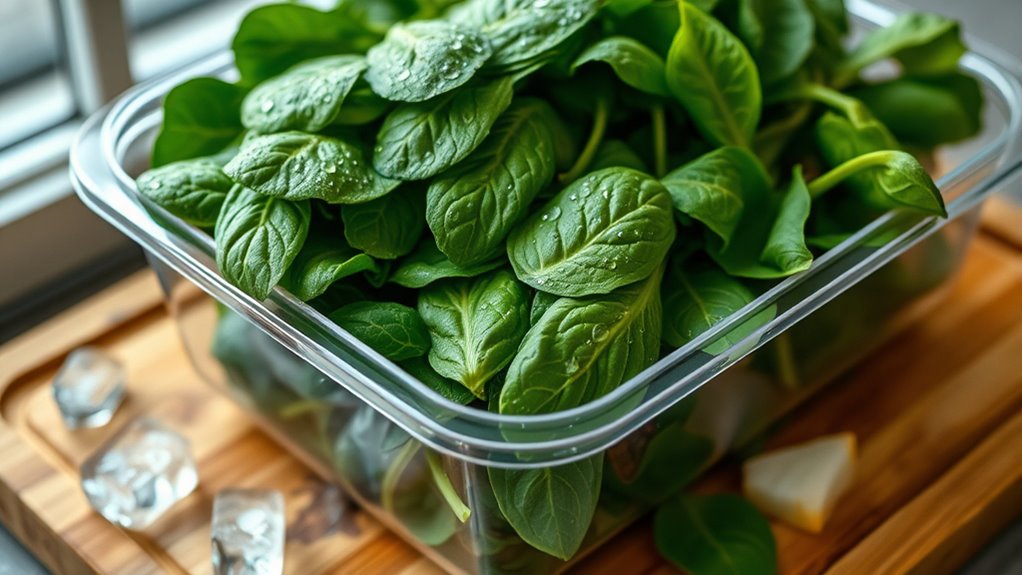
How can you keep your spinach fresh for longer? Start by washing it in cool water with vinegar to remove pathogens.
Remove any damaged leaves and consider taking off the stems for easier use. Dry your spinach thoroughly with a salad spinner or paper towels to eliminate excess moisture.
Store your spinach in breathable containers with ventilation holes, or use silicone bags for an eco-friendly option. Line containers with paper towels to absorb any moisture.
Keep your spinach in the crisper drawer of your refrigerator at temperatures below 40°F (4°C). Avoid washing it before storage, and regularly check for moisture or spoilage, replacing paper towels as needed to maintain its freshness.
Freezing Spinach for Long-Term Use

Freezing spinach is a fantastic way to preserve its freshness and nutrients, especially when you have an abundance on hand.
Freezing spinach is an excellent method to maintain its freshness and nutrients, perfect for times of abundance.
You can freeze fresh spinach without blanching if you plan to use it within six months. Just make sure the leaves are dry to prevent ice crystals.
Place the spinach in a Ziploc freezer bag, squeeze out as much air as possible, and pop it in the freezer.
For versatility, consider pureeing the spinach with a little water, then freeze it in ice cube trays for easy smoothie additions.
Properly stored, your frozen spinach can last up to a year, allowing you to enjoy its nutritional benefits all year round.
Best Practices for Long-Term Storage

When you're looking to keep spinach fresh for an extended period, employing the right storage techniques is crucial.
First, store spinach in the crisper drawer of your fridge, where temperature and humidity remain consistent. Use breathable containers or perforated bags to prevent moisture buildup, and avoid washing the spinach until you're ready to use it.
If it's been washed, make sure it's thoroughly dried before storage. Keep spinach away from strong-smelling foods to avoid odor transfer.
For added freshness, consider using silicone bags or containers with paper towels to absorb excess moisture.
Regularly inspect the spinach for any signs of spoilage, like yellowing leaves or sliminess, and discard any damaged pieces promptly.
Handling Pre-Washed Spinach
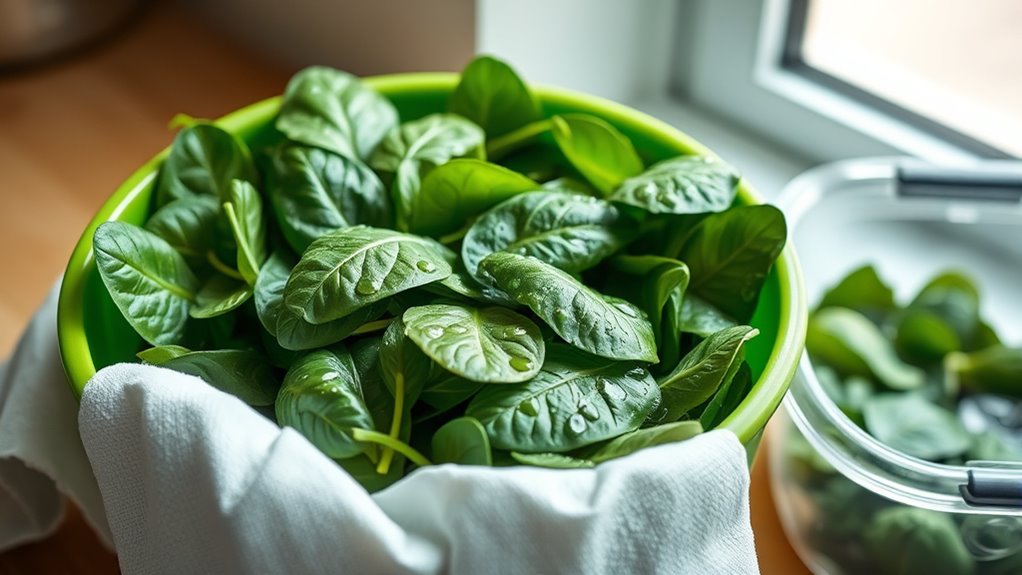
After mastering the best practices for long-term storage, handling pre-washed spinach requires careful attention to maintain its freshness.
First, dry the spinach thoroughly to eliminate excess moisture, which can lead to spoilage. Store it in breathable containers or plastic bags with ventilation holes to promote airflow.
Place the spinach in the crisper drawer of your refrigerator, where temperatures and humidity levels are consistent. Try to use pre-washed spinach within 3 to 5 days for optimal freshness.
Avoid washing it again until you're ready to eat, and keep an eye out for any signs of spoilage. If you can't use it soon, consider freezing it to extend its shelf life.
Refreshing Wilted Spinach
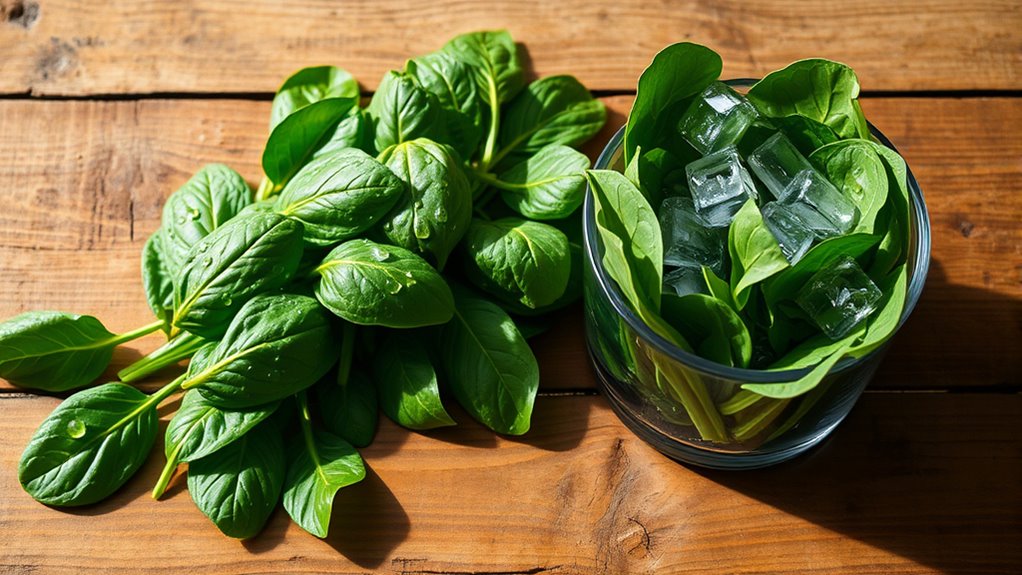
If you find your spinach wilting and losing its appeal, don't worry—reviving it's simple. Just submerge the wilted leaves in ice-cold water for 15 to 20 minutes. This method helps restore their crispness and freshness, making your spinach ready for use immediately.
After soaking, gently pat the leaves dry with paper towels to remove any excess moisture. To maintain the freshness of your revived spinach, store it in a dry environment. Remember, excess moisture can lead to wilting again, so keep it in a sealed container with paper towels.
Frequently Asked Questions
Can Spinach Be Stored at Room Temperature?
You shouldn't store spinach at room temperature. It spoils quickly due to moisture and temperature fluctuations, leading to yellowing and wilting.
Nutrient loss accelerates, particularly for folate and carotenoids. If you want to keep your spinach fresh, aim for refrigeration instead.
Proper storage helps retain its nutrients and prolongs its shelf life, allowing you to enjoy it for several days without compromising quality.
Always prioritize cooler conditions for optimal freshness.
What Types of Containers Are Best for Freezing Spinach?
When you're freezing spinach, choose containers that ensure freshness. Freezer bags work great because you can easily remove air, preventing freezer burn.
Airtight containers are perfect for blanched leaves, while ice cube trays help you create convenient spinach cubes.
Silicone ziplock bags offer flexibility and an airtight seal.
Is It Safe to Eat Spinach Past Its Expiration Date?
You might be wondering if it's risky to eat spinach past its "best by" date.
The truth is, it can still be safe if you've stored it properly. Just keep an eye out for signs of spoilage—dark spots, a slimy texture, or an off smell.
If you notice any of these, it's better to toss it. Remember, consuming spoiled spinach can lead to foodborne illness, so always check before you bite!
How Can I Tell if Frozen Spinach Has Gone Bad?
You can tell if frozen spinach has gone bad by checking a few key signs.
First, look for color changes; vibrant green means it's good, while yellow or brown indicates spoilage.
Next, feel the texture—if it's slimy or mushy after thawing, toss it.
Lastly, trust your nose; an off or sour smell is a clear sign it's no longer safe to eat.
Also, check for freezer burn and packaging damage.
Can I Store Spinach With Other Vegetables?
You can store spinach with other vegetables, but it's not the best idea.
Spinach is sensitive to moisture and ethylene gas, which some fruits and veggies produce. If you do mix them, use breathable containers and consider adding absorbent materials like paper towels to manage moisture.
Regularly check for spoiled items to prevent cross-contamination.
Ideally, keeping spinach separate will help maintain its freshness and extend its shelf life.
Conclusion
So, you thought storing spinach was a simple task? Ironically, it's a delicate art! By following these tips, you can keep your greens fresh and vibrant, avoiding that sad, wilted fate. Whether you're opting for the fridge or the freezer, the right techniques make all the difference. Remember, a little attention now saves you from tossing out a soggy mess later. Who knew that keeping spinach fresh could be a culinary adventure? Enjoy your crisp, leafy triumph!

